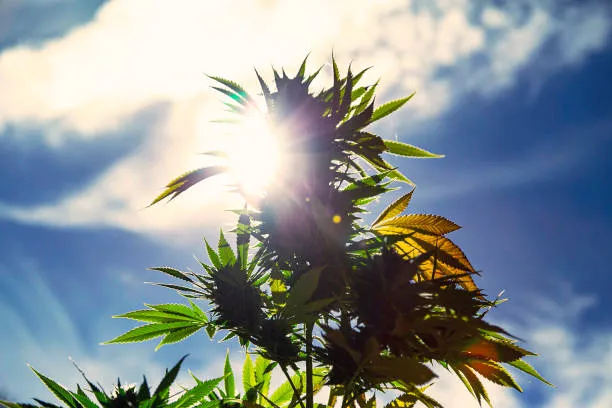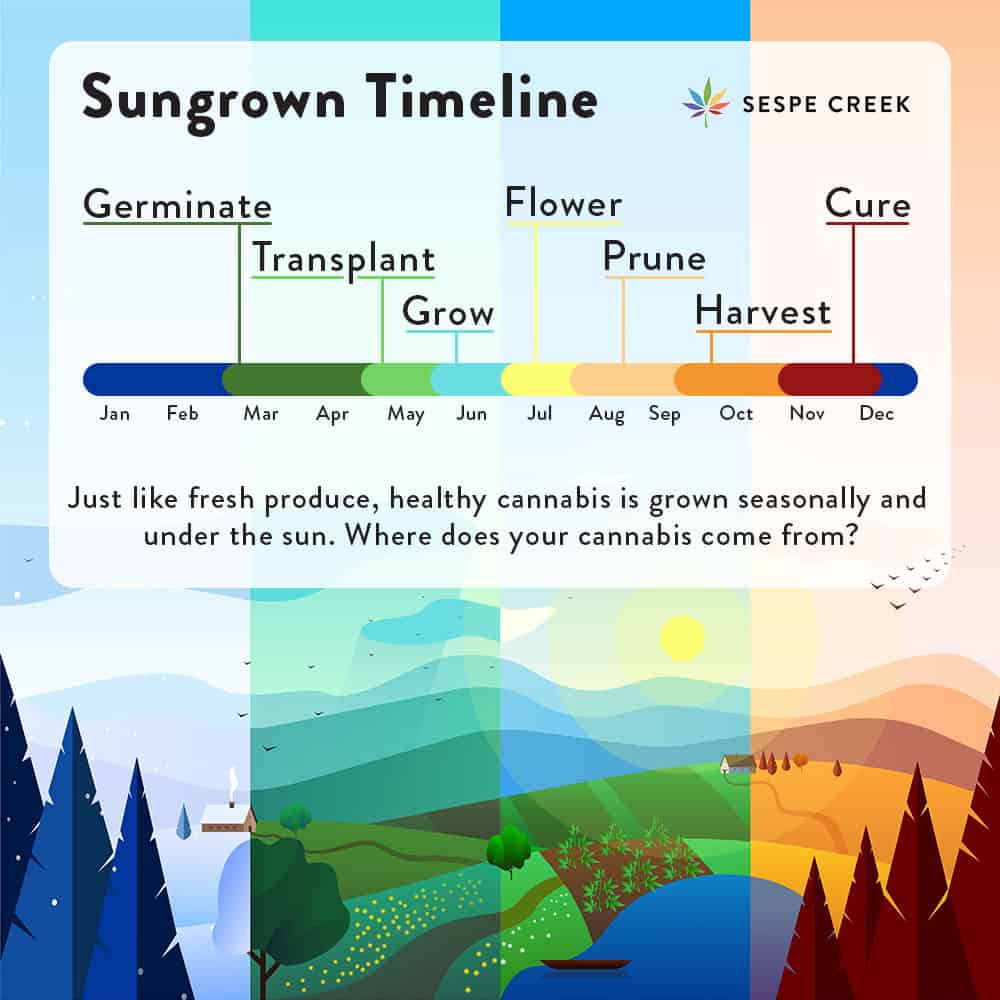
In California we are fortunate to have such ideal conditions for growing a plethora of different crops. When it comes to cannabis, we believe we should apply the same healthy farming principles that we use on the produce we grow to eat. Cannabis has its own growth and harvest times, just like fruits and vegetables.
We hope this Sungrown Timeline helps put the lifecycle of this plant we all love into perspective, from germination to the cured flower on our shelves.

Germinate
March – June
Germination sets the foundation for a successful cannabis grow. Ensure proper germination by selecting high-quality, genetically stable seeds from reputable sources, ideally with a focus on organic or sustainably produced seeds. To further support the environment, consider using renewable or recycled materials for germination containers.
Creating an optimal environment for germination involves maintaining consistent temperature, humidity, and darkness. Utilize energy-efficient heating solutions, such as seedling heat mats, and control humidity with eco-friendly methods like reusable humidity domes. Monitor and adjust these conditions as necessary to ensure successful germination and the establishment of healthy seedlings.
Transplant
April – July
Transplanting seedlings is a delicate process that requires attention to detail and a focus on sustainability. When choosing containers for transplanting, consider options made from biodegradable materials, like coco coir or peat pots, which can be planted directly into the ground, reducing transplant shock and minimizing plastic waste. For growers using reusable containers, thoroughly clean and sanitize them between grows to minimize the risk of pests and diseases.
Select a nutrient-rich, organic soil mix or create your own using locally sourced compost and other natural amendments. This practice promotes healthy plant growth while reducing the need for synthetic fertilizers and minimizing environmental harm. Ensure proper transplant timing to minimize stress on the plants and encourage strong, resilient root systems.
Grow
June – October
During the vegetative growth phase, cannabis plants require proper care and attention to thrive. Implement sustainable practices such as water conservation and natural pest control methods to minimize the environmental impact of your grow. Drip irrigation systems, rainwater collection, or even recycling household water (greywater) can help reduce water waste while meeting the plants’ needs.
Embrace Integrated Pest Management (IPM) strategies to control pests and diseases without relying on chemical pesticides. Employ physical barriers, beneficial insects, and companion planting to maintain a balanced ecosystem and protect your cannabis plants naturally.
Flower
July – October
The flowering phase is when cannabis plants produce the highly sought-after buds. To support the plants during this stage, maintain a healthy growing environment and minimize energy consumption. For indoor grows, energy-efficient LED lights are an excellent choice, as they produce less heat and consume less electricity than traditional lighting systems.
For outdoor cannabis cultivation, take advantage of California’s abundant sunlight and optimize the plants’ exposure to natural light. This practice not only reduces energy consumption but also encourages robust growth and potent buds.
Continuously monitor and adjust environmental factors such as temperature, humidity, and air circulation during the flowering phase to prevent mold and bud rot, which can significantly compromise the quality and yield of your crop.
Prune
August – October
Pruning is an essential practice for maximizing light exposure, directing plant energy towards flower production, and maintaining a healthy plant structure. When pruning, use sharp, sterilized tools to ensure clean cuts and minimize the risk of infections.
Remove only the necessary leaves and branches, avoiding excessive pruning that could stress the plant and impact its overall health. Compost pruned material to create nutrient-rich amendments for future grows or use the leaves as mulch to suppress weeds and retain soil moisture.
Harvest
October – November
Monitor the maturity of the buds and the trichomes closely to determine the optimal harvest time, as this can significantly affect the final product’s potency, flavor, and aroma. Trichomes should be mostly cloudy with a few amber ones, indicating peak cannabinoid and terpene levels. Harvesting too early or too late can lead to a less desirable outcome.
Harvest the cannabis plants either all at once or in stages, depending on the maturity of the buds and the plants’ specific needs. Some growers may choose to harvest the top buds first, allowing lower buds to receive more light and continue maturing. This method, known as “staggered harvesting,” can help maximize yields and produce consistent quality across the entire plant.
Be gentle when handling the harvested buds to prevent trichome loss and damage to the delicate plant material.
Cure
November – December
Curing cannabis is a critical final step in the cultivation process that greatly affects the final product’s flavor, aroma, potency, and shelf life. The curing process allows for the gradual release of residual moisture and chlorophyll within the buds, leading to a smoother and more enjoyable smoking or vaping experience.
To begin the curing process, store the trimmed and dried buds in airtight containers, such as glass jars or biodegradable bags. Glass jars are an eco-friendly choice, as they are reusable and do not leach chemicals into the buds. If using biodegradable bags, select ones made from sustainable materials, such as plant-based polymers.
Maintain consistent temperature and humidity levels during the curing process to prevent mold growth and ensure optimal curing conditions. Ideal temperatures for curing range between 60-70°F (15-21°C), while relative humidity should be maintained at 55-62%. Use hygrometers to monitor the humidity inside the containers and employ moisture-absorbing packets, like silica gel or humidity packs, to help regulate the environment.
Regularly burp the containers by opening them for a short period (10-15 minutes) to release excess moisture and allow fresh air to enter. This practice is particularly important during the first few weeks of curing when the buds are still releasing moisture. As the curing process progresses, you can decrease the frequency of burping the containers.
Curing times can vary depending on the specific strain and desired outcome. Generally, a curing period of 2-4 weeks is sufficient, but some growers opt for longer curing times (up to several months) to achieve the best possible flavor and potency.
Summary
In California, we are blessed with the perfect conditions for growing a diverse range of crops, including cannabis. By understanding and implementing sustainable practices throughout each stage of the cannabis life cycle, from germination to curing, we can ensure a high-quality product that aligns with our values and supports a healthier planet.
This Sungrown Timeline offers a comprehensive overview of the cannabis cultivation journey, showcasing the importance of each phase and the opportunities for environmentally conscious practices. By embracing these principles, we can not only produce exceptional cannabis but also contribute to a thriving, sustainable industry that we can be proud of. With each step taken towards sustainable cannabis cultivation, we are one step closer to a greener and more prosperous future.
